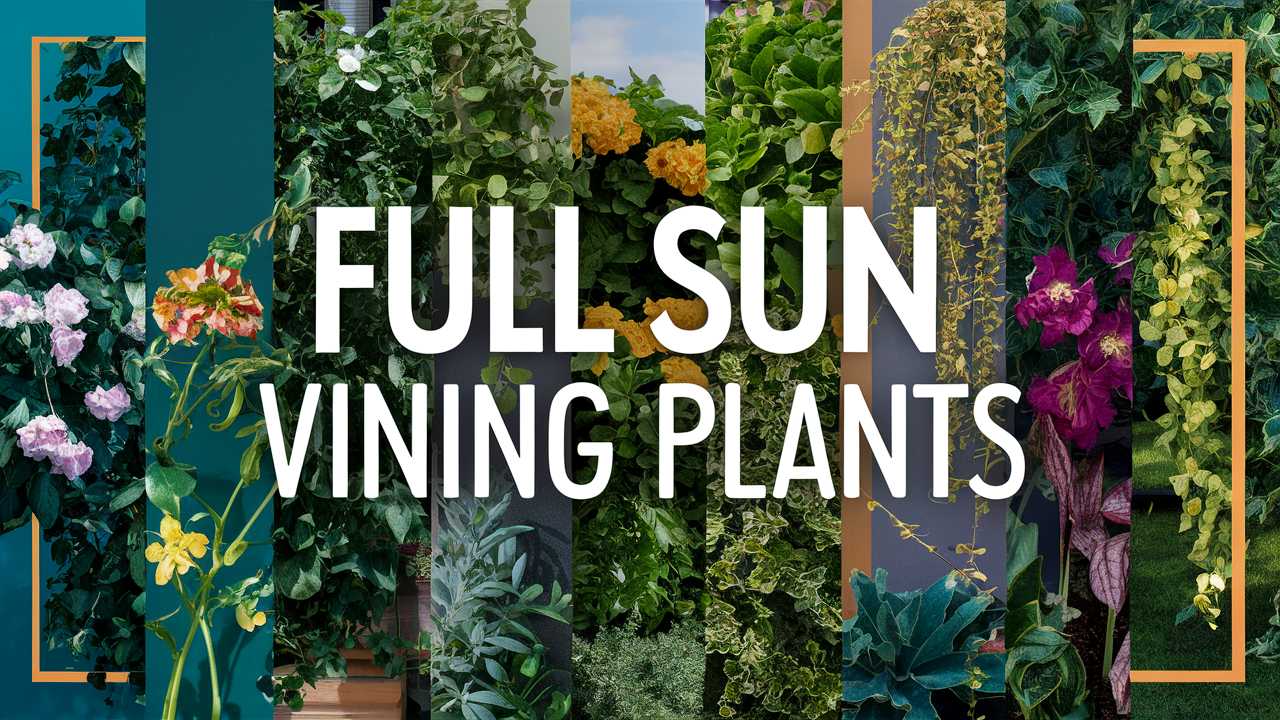In this guide, we’ll explore some of the best full-sun vining plants, highlighting their unique features, benefits, and care requirements. Get ready to transform your garden into a lush paradise with these stunning varieties!
Bougainvillea

Bougainvillea is like the showstopper of the vining world, renowned for its vibrant hues and ability to flourish in full sun. Originating from South America, this perennial plant displays papery bracts that come in shades of pink, purple, red, orange, and white, creating a spectacular burst of color against its green foliage.
One of the most remarkable aspects of Bougainvillea is its resilience. Once established, it requires minimal watering and can withstand drought, making it perfect for gardeners in hot climates. This vining plant can climb structures, walls, and fences effortlessly, often reaching heights of 10 to 30 feet or more, depending on the species.
Bougainvillea prefers well-drained soil but can adapt to various soil types, as long as it’s not overly wet. They thrive best in nutrient-rich environments, but too much fertilizer can lead to excessive leaf growth at the expense of flowers. Pruning is essential to maintain shape and encourage blooming, making it a delight for gardeners who enjoy some hands-on involvement.
Everlasting Pea (Lathyrus latifolius)
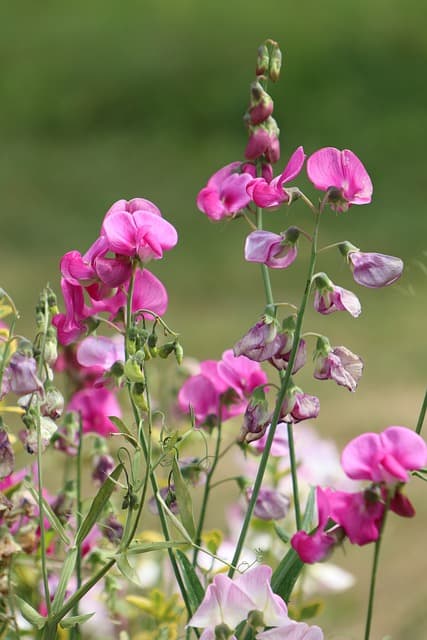
If you’re looking for a perennial vining plant with a fragrant flair, consider the Everlasting Pea. This hardy climber produces clusters of delicate, sweet-smelling pink to purple flowers that bloom from late spring to fall, attracting bees and butterflies.
The Everlasting Pea can reach heights of up to 6 feet and thrives in full sun, making it an excellent choice for a trellis or fence. Its ability to adapt to various soil types means it’s versatile enough for different garden settings. Unlike other climbing plants, this pea doesn’t produce edible pods, but its ornamental quality more than compensates for this.
Care for the Everlasting Pea involves ensuring it has a sturdy support structure since its tendrils will cling to anything they can find. Little water is needed once established, but regular pruning will encourage better growth and flowering. It’s a fantastic choice for those passionate about attracting pollinators to their garden.
Honeysuckle
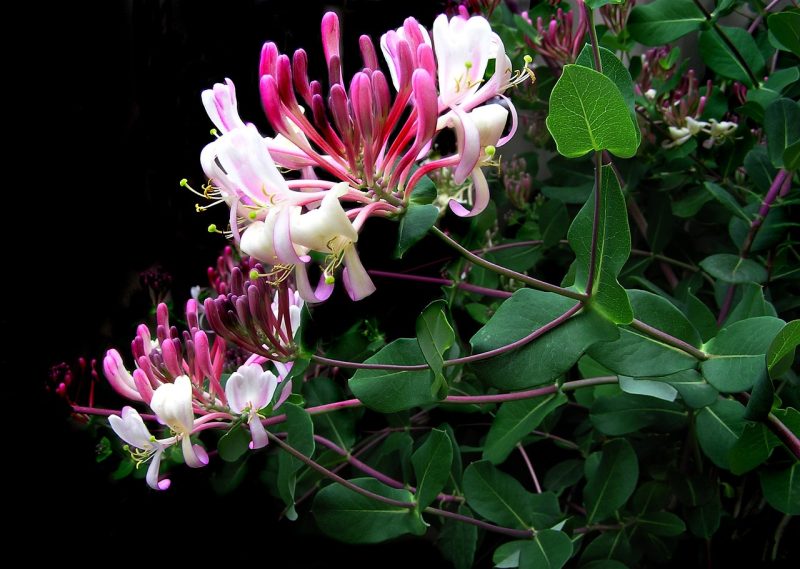
Honeysuckle is a timeless classic when it comes to vining plants. Known for its enchanting scent and tubular flowers, which attract hummingbirds and butterflies, Honeysuckle is more than just an appealing addition—it’s a crucial player in your garden’s ecosystem.
There are numerous species of Honeysuckle, providing a variety of flowers ranging from creamy yellows to vibrant reds. Most thrive in full sun and can grow up to 30 feet tall, perfect for covering trellises, arbors, or fences. Its vigorous growth can often take over spaces, so regular pruning is essential to keep it in check.
Honeysuckle prefers well-drained soil but can tolerate drought conditions once established. It’s a wonderful choice for gardeners seeking a fragrant experience, as the scent of its flowers can linger through the evening. Moreover, its ability to attract various pollinators will promote a healthy garden environment, enhancing biodiversity.
Coral Vine

Coral Vine, also known as Mexican Creeper, is a fast-growing vining plant that never fails to impress with its cascading clusters of pink flowers. This tropical perennial is perfect for those who want to create a dramatic display in their full sun garden.
Simple to cultivate, Coral Vine flourishes in poor soil and is drought-tolerant, making it a low-maintenance option for gardeners. The plant can reach impressive heights, often exceeding 20 feet, and works well for covering unsightly structures, walls, or fences.
One of the exciting aspects of Coral Vine is how it attracts butterflies, providing an inviting space for nature enthusiasts. It does best in areas with plenty of sun; however, it can adapt to partial shade if necessary. Regular pruning helps manage its growth and ensures continuous blooming throughout the season—making it an eye-catching addition to any landscape.
Carolina Jessamine

Carolina Jessamine, or Gelsemium sempervirens, is an evergreen vine known for its glossy green leaves and delightful, trumpet-shaped yellow flowers. This native plant supports local ecology by attracting a variety of pollinators and fits beautifully in full sun or partial shade.
With a growth potential of up to 20 feet, Carolina Jessamine can deftly climb trellises, fences, or even large trees, creating a picturesque scene in any garden. Its sweet fragrance is especially prominent during the early spring when the plant is in full bloom.
Gardeners will appreciate that Carolina Jessamine prefers well-drained soil and can adapt to various conditions. While it is relatively low-maintenance, encourage flowering through light pruning and regular watering during dry spells. This vining wonder not only enhances the garden’s aesthetic but also brings charm and allure with its captivating scent.
Lady Banks Rose
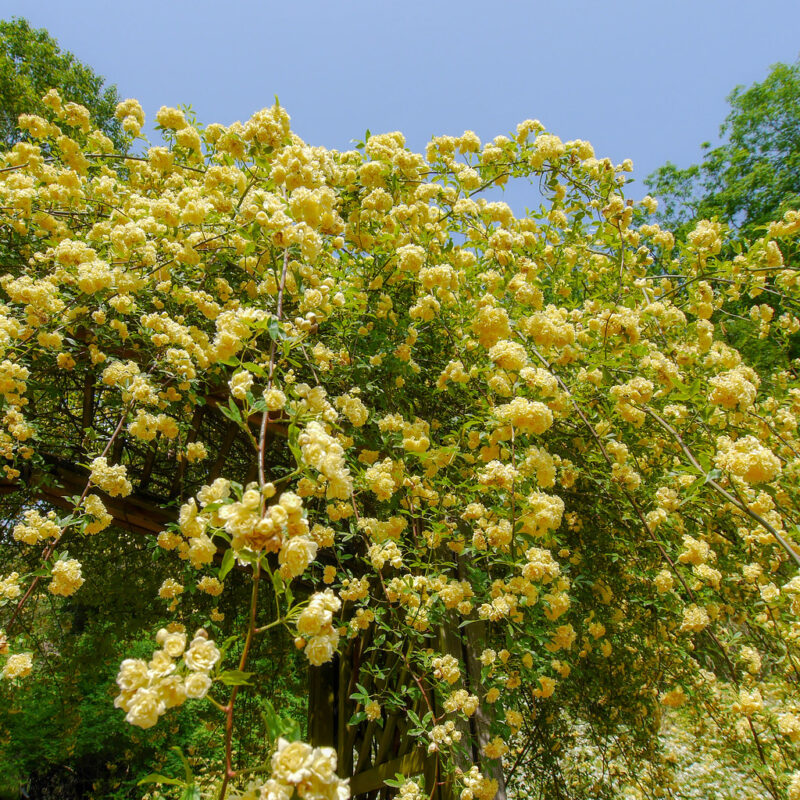
Lady Banks Rose is a vigorous climbing plant celebrated for its charming, small, and fragrant yellow or white flowers. With a strong growth habit, it can quickly reach heights of 10 to 20 feet, making it a splendid choice for trellises, arbors, and walls.
What sets this rose apart is its thornless nature, making it safer and easier to maintain than traditional climbing roses. This plant is particularly forgiving, as it thrives in full sun and is tolerant of poor soil conditions.
Despite their ease of growth, Lady Banks Roses can become a bit unruly if not pruned regularly. A light trimming after flowering will stimulate new growth and maintain their shape. Also, this rose is known to withstand periods of drought, offering the gardener peace of mind without frequent watering.
Mexican Flame Vine
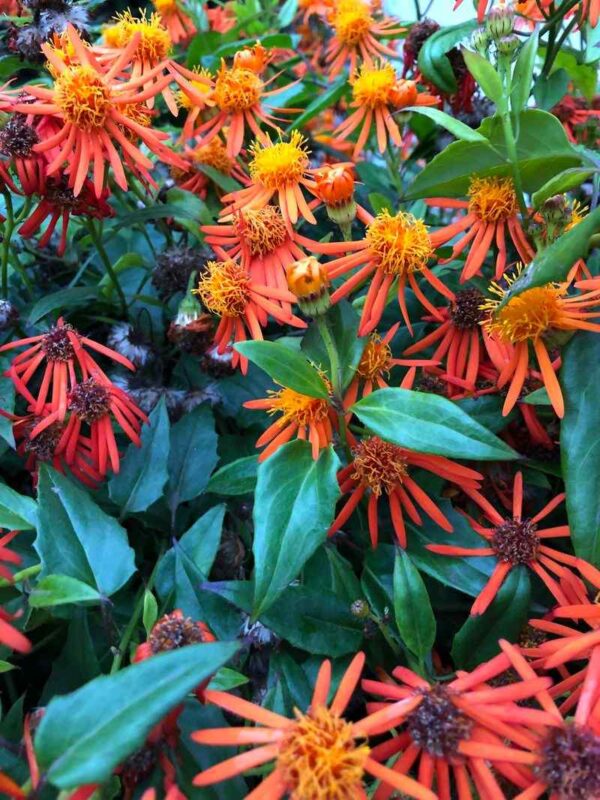
Bringing a splash of color to your garden, the Mexican Flame Vine is a striking perennial vine that showcases vibrant orange-red flowers. This eye-catching plant thrives in full sun and can quickly cover an arbor, trellis, or wall, reaching heights of over 10 feet.
Mexican Flame Vine is a robust grower, typically blooming from summer through fall, offering extended color to the landscape. Its growth is rapid, so it’s essential to provide sturdy support and consider regular pruning to control its spread.
This vine attracts butterflies and hummingbirds, making it a delightful addition for nature lovers. Thriving in a range of soil types, it’s drought-tolerant once established. Regular watering will promote prolific blooming. For those looking to create a vivid, lively atmosphere in their garden, the Mexican Flame Vine is an impressive choice.
Wisteria (Wisteria frutescens)
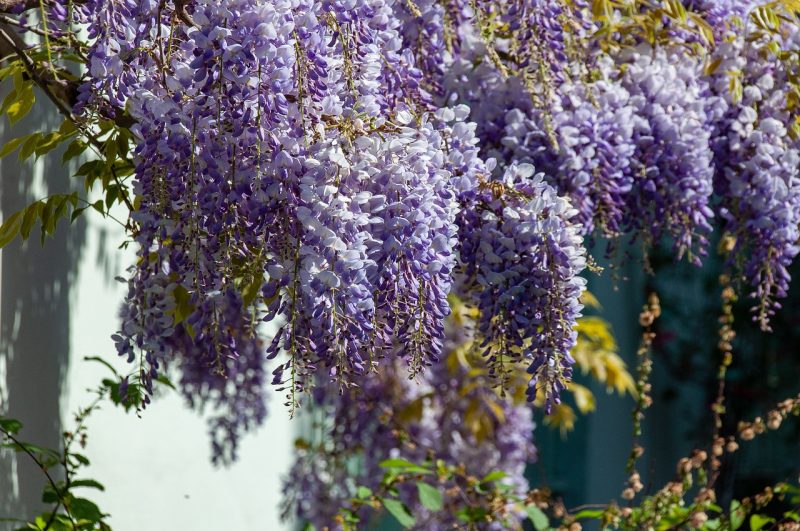
Wisteria is the epitome of elegance, known for its stunning cascades of bluish-purple flowers that create a magical atmosphere. Often associated with Southern gardens, this deciduous climbing vine can reach extraordinary lengths, sometimes growing over 30 feet if conditions are just right.
For the best results, Wisteria thrives in full sun, and while it prefers rich, well-drained soil, it can adapt to various soil types. Planting Wisteria near a sturdy structure will allow it to display its beautiful blooms effectively. However, keep in mind that this vigorous grower can become invasive if left unchecked, necessitating regular pruning to maintain its health.
Wisteria’s breathtaking blooms typically emerge in spring, filling the air with lovely fragrance. After flowering, pruning can help reshape the vine and encourage even more spectacular blossoms the following season. For those desiring a touch of enchantment in their garden, Wisteria is exceptionally rewarding.
Virginia Creeper

Virginia Creeper may not be as delicate as some other vining plants, but its toughness, adaptability, and stunning fall foliage make it a fantastic addition to any full-sun garden. This fast-growing perennial can reach heights of 15 to 30 feet, quickly covering walls or fences.
The real delight of Virginia Creeper comes from its lush green leaves that transform into breathtaking shades of red, orange, and purple in autumn. This show of color creates a dramatic visual impact and enhances your landscape throughout the seasons.
While Virginia Creeper is tolerant of poor soil conditions and thrives in full sun, it can also handle partial shade. Its low maintenance requirements and ability to attract birds and beneficial insects make it a smart choice for natural gardening landscapes. Regular pruning during the growing season will help contain its growth and promote denser foliage.
Morning Glory
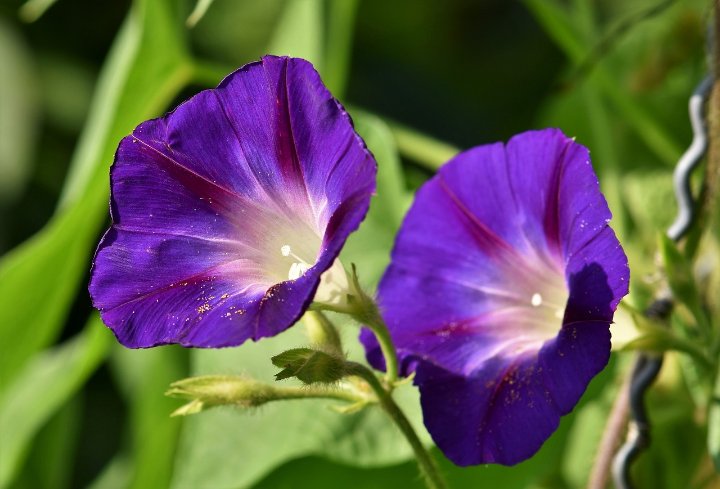
Morning Glory is a classic summer favorite for gardeners, known for its striking, trumpet-shaped blooms that can adorn a trellis, fence, or wall. These cheerful flowers come in a kaleidoscope of colors, including purple, blue, pink, and white, making them a versatile choice for any palette.
Thriving in full sun and tolerant of poor soils, Morning Glory is effortless to grow, making it a favorite among novice gardeners. These vining plants can reach heights of up to 10 feet and will quickly cover structures, producing vibrant blooms from spring through frost.
Though they are low-maintenance plants, you may want to keep an eye on their growth. Morning Glories have a tendency to spread rapidly, so regular pruning helps control their wanderlust. Additionally, it’s essential to plant them where they can climb unabated, as they need a sturdy support structure to thrive. Their soft petals and unique shape will enchant anyone savoring the tranquility of your garden.
Black-Eyed Susan Vine
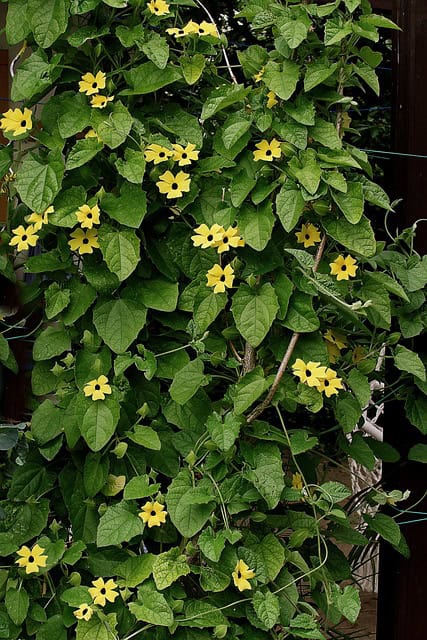
The Black-Eyed Susan Vine is a delightful addition that brings warmth and joy to any vertical space. Recognizable for its distinctive yellow flowers with dark centers reminiscent of the beloved perennial Black-Eyed Susan, this vining plant creates a stunning contrast against green foliage.
Reaching heights of about 6 to 10 feet, the Black-Eyed Susan Vine is suitable for trellises and hanging baskets alike. It does exceptionally well in full sun, although it can tolerate partial shade. This plant adapts easily to most soil types and thrives with minimal care.
Regular watering will help achieve a lush, vigorous growth; however, the Black-Eyed Susan Vine is relatively drought-tolerant once established. Pruning is key to encouraging continuous blooming throughout the growing season, and deadheading spent flowers will promote more blossoms. This charming vine is perfect for gardens seeking a combination of cheerful color while inviting bees and butterflies to visit.
Star Jasmine
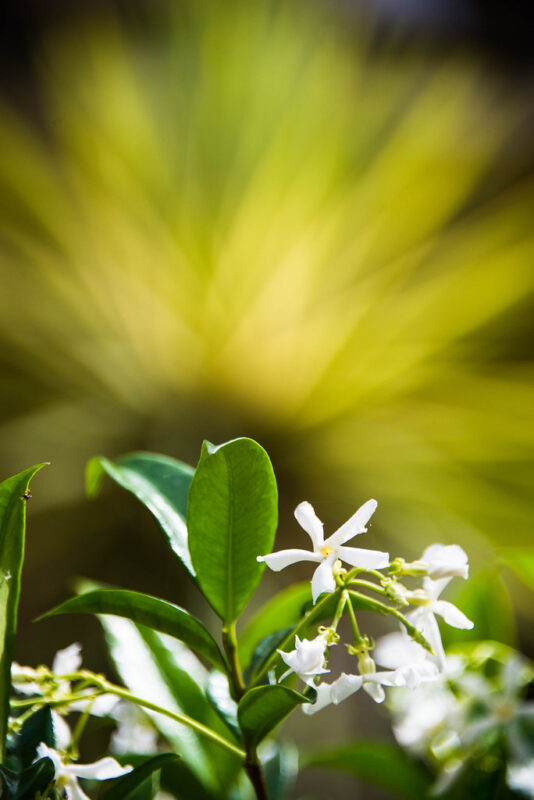
Star Jasmine, or Trachelospermum jasminoides, is an evergreen climber that enchants with its fragrant star-shaped white flowers. Perfect for covering trellises, fences, or as ground cover, Star Jasmine flourishes in full sun to partial shade.
This lovely vine typically reaches heights of about 10 to 15 feet and offers a variety of uses in the garden. Its glossy green leaves provide excellent coverage, while the scented flowers bloom in spring and summer, releasing a captivating aroma that wafts through your garden.
Star Jasmine is relatively low-maintenance, thriving in well-drained soil and being drought-tolerant once established. Regular pruning will help maintain desired growth and shape, ensuring you enjoy its blooms for years to come. As a bonus, the flowers are known to attract pollinators, making this plant not only beautiful but environmentally friendly as well.


